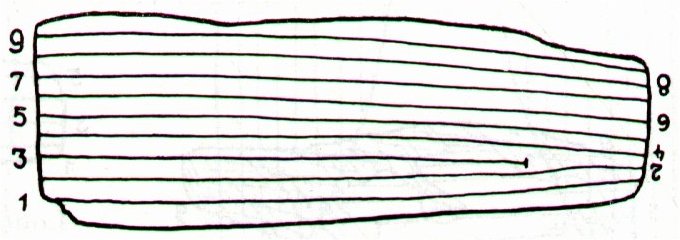The wooden tablet was shorter at right which squeezed the available
space.
... They were Ranginui, the Sky
Father, and Papatuanuku, the Earth Mother, both
sealed together in a close embrace. Crushed between the
weight of their bodies were their many children, whose
oppression deepened. They yearned to be free; they fought
their parents and each other to break loose. Tuumatauenga,
virile god of war, thrust and shouted; Tangaroa of
the oceans whirled and surged; Tawhirirangimaatea,
Haumiatiketike and Rongomatane, of wild foods and
cultivated crops, tried their best but were not successful;
and Ruamoko, god of earthquakes, yet to be born,
struggled in the confinement of his mother's womb ... Of
them all, Taane Mahuta, the god of the forests, was
the most determined; he set his sturdy feet upon his
father's chest, and braced his upper back and shoulders
against the bosom of his mother. He pushed; and they parted.
So the world, as the Maori understand it, came into being
...
But the creator of the glyph text found a solution to this
dilemma, viz. to let line a3 finish early, and then aligning the glyphs
in order to put Ancha (θ Aquarii) at the end of line a3:
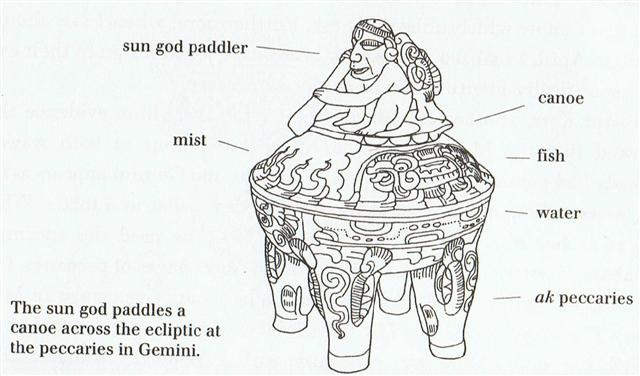
|
Febr 16 |
17 (14 * 29½) |
18 (414) |
19 (50) |
20 |
21 (80 - 4 *
7) |
|
No star listed (332) |
η Piscis Austrini (333.4)
*292.0 = *333.4 - *41.4 |
Rooftop-12
(Swallow)
22h (334.8)
KAE UH (Roof) =
ο
Aquarii
(334.0),
AL KURHAH (White Spot) =
ξ
Cephei (334.4),
SADALMELIK (Lucky King) =
α
Aquarii,
AL DHANAB (The Tail) =
λ
Gruis
(334.6),
ι
Aquarii,
ν
Pegasi (334.7)
*293.0 = *334.4 - *41.4 |
ι
Pegasi (335.0),
ALNAIR (The Bright One) =
α
Gruis
(335.1),
μ
Piscis Austrini,
υ
Piscis Austrini (335.3),
WOO (Pestle) =
π
Pegasi
(335.7),
BAHAM =
θ
Pegasi (Good Luck of the Two Beasts),
τ
Piscis Austrini (335.8) |
ζ
Cephei (336.2),
λ
Cephei (336.3), -/270 Lac.
(336.7), λ Piscis Austrini (336.8) |
μ
Gruis (337.0),
ε
Cephei (337.2), 1/325 Lac. (337.3),
ANCHA (Hip) =
θ
Aquarii (337.4),
ψ
Oct.
(337.5), α Tucanae (337.9)
*296.0 = *337.4 - *41.4 |
 |
 |
 |
 |
 |
 |
 |
|
Ea3-30 (95) |
Ea3-31 |
Ea3-32 |
Ea3-33 |
Ea3-34 |
Ea3-35 (100) |
| tagata rere te toki |
kua tua ko te tino
|
te
toki |
marama |
toki |
|
Tino.
1. Belly (as reported by a
Spaniard in 1770). 2. Genitalia (modern usage).
3. Trunk (of a tree), keel (of a boat); tino
maîka, banana trunk; tino vaka, keel.
Vanaga. Body, matter; mea tino, material;
tino kore, incorporeal. P Pau.: tino,
a matter, a subject. Mgv.: tino, the
body, trunk. Mq.: tino, nino, the
body. Ta.: tino, id. Churchill.
Tua. 1.
Back, shoulder, tu'a ivi, shoulder blade;
tu'a ivi more, lumbago; moa tu'a ivi raá,
'sun-back chicken': chicken with a yellow back which
shines in the sun. 2. Behind (a locative adverb,
used with i, ki, a, o, etc). Tu'a-papa,
pelvis, hips. Vanaga. 1. Behind, back, rear; ki
tua, after; o tua, younger; taki tua,
perineum. 2. Sea urchin, echinus. The word must have
a germ sense indicating something spinous which will
be satisfactorily descriptive of the sea urchin all
spines, the prawn with antennae and thin long legs,
and in the Maori the shell of Mesodesma spissa.
Tuaapapa, haunch, hip, spine. Tuahaigoigo,
tattooing on the back. Tuahuri, abortion;
poki tuahuri, abortive child. Tuaivi,
spine, vertebræ, back,
loins; mate mai te tuaivi,
ill at ease. Tuakana,
elder, elder brother; tuakana tamaahina,
elder sister. Tuamouga,
mountain summit. Tuatua,
to glean. Mgv. tua: To fell, to cut
down. Ta.: tua, to cut. Mq.: tua, to
fell, to cut down. Ma.: tua, id. Tuaki,
to disembowel. Ma.: tuaki, to clean fish.
Tuavera, the last breadfruit spoiled by the
wind. Ta.: tuavera, burnt by the sun.
Churchill.
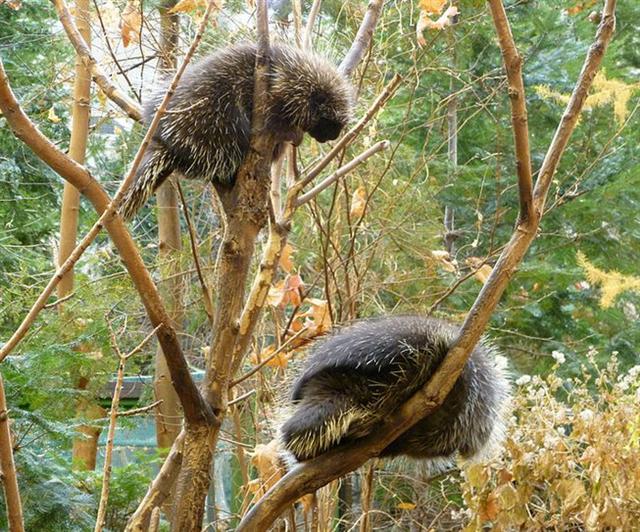 |
He would thus be able to let line Ea1 begin 99 right ascension days
(glyphs) earlierm, viz. at the time when the Foundation Stone (Alcyone, *56)
was visible at the right ascension line close to the Full Moon:

|
Nov 14
(318) |
15 (137 +
182) |
16
(320) |
17 (504 -
183) |
18 (320 + 2) |
|
VISIBLE
CLOSE TO THE FULL MOON: |
|
Hairy
Head-18 (Cockerel)
/
Temennu-3 (Foundation
Stone)
ALCYONE
(56.1),
PLEIONE (28 Tauri), ATLAS (27 Tauri)
(56.3) |
MENKHIB (Next to the Pleiades =
ζ
Persei
(57.6)
PORRIMA (γ Virginis) |
ZAURAK (Boat) = γ Eridani
(58.9) |
λ Tauri (59.3), ν Tauri (59.9) |
4h (60.9)
JĪSHUĬ = λ Persei
(60.7)
COR CAROLI (α Canum Ven.) |
 |
|
May 16
(501) |
17 |
18 (74 + 64) |
19 (139) |
20 (20
weeks) |
 |
 |
 |
 |
 |
|
Ea1-1 |
Ea1-2 |
Ea1-3 |
Ea1-4 |
Ea1-5 |
|
E hakamata
hia tu mai tae
vahu ku huku hia
te vaha ko te tagata - kua mau ki te
hukiga |
|
Va.
1. Hakava, judge, judgement. T Mgv.:
akava, to judge, to pass sentence.
Pau.: haava, to judge, to conjecture.
Ma.: whakawa, to charge with crime,
to condemn. Ta.: haava, to judge. 2.
Hakava, to speak. P Mgv.: va,
to speak. Mq.: vaa, to chatter like a
magpie. The Marquesan retains more of the
primal sense although the simile is an alien
importation. In Samoa va means a
noise, in Tonga va is a laughing
noise, in Futuna va is the disorderly
cry of tumult, and probably it is the
initial element of Viti wa-borabora
to speak quickly and confusedly as when
scolding. Its only identification in
Tongafiti territory is Hawaii wawa
the confused noise of a tumult ...
Churchill. Ta.: va, space between the
leaves in a roof. Sa.: va, space
between. Ma.: wa, interval.
Churchill.
Hu. 1. Breaking of
wind. T Mgv., uu, to break wind. Mq.,
Ta.: hu, id. 2. Whistling of the
wind, to blow, tempest, high wind. P Pau.:
huga, a hurricane. Churchill. Mgv.:
hu, to burst, to crackle, to snap.
Ha.: hu, a noise. Churchill.
Ha. 1. Four. 2. To
breathe. Hakaha'a, to
flay, to skin. Vanaga. 1. Four. P Mgv., Mq., Ta.: ha, id.
2. To yawn, to gape. 3. To heat. 4.
Hakaha, to skin, to flay; unahi
hakaha, to scale fish. Mgv.: akaha,
to take to pieces, to take off the bark or
skin, to strip the leaves off sugarcane. 5.
Mgv: ha, sacred, prohibited. Mq.:
a, a sacred spot. Sa.: sa, id.
Churchill.
Vaha.
Hollow; opening; space between
the fingers (vaha rima); door cracks
(vaha papare). Vahavaha, to
fight, to wrangle, to argue with abusive
words. Vanaga. 1. Space, before T; vaha
takitua, perineum. PS Mgv.: vaha,
a space, an open place. Mq.: vaha,
separated, not joined. Ta.: vaha, an
opening. Sa.: vasa, space, interval.
To.: vaha, vahaa, id. Fu.:
vasa, vāsaà,
id. Niuē: vahā.
2. Muscle, tendon; vahavaha,
id. Vahahora
(vaha
1 - hora
2), spring. Vahatoga
(vaha
1 - toga
1), autumn. 3. Ta.: vahavaha,
to disdain, to dislike. Ha.:
wahawaha,
to hate, to dislike. Churchill.Vaha.
Hollow; opening; space between
the fingers (vaha rima); door cracks
(vaha papare). Vahavaha, to
fight, to wrangle, to argue with abusive
words. Vanaga. 1. Space, before T; vaha
takitua, perineum. PS Mgv.: vaha,
a space, an open place. Mq.: vaha,
separated, not joined. Ta.: vaha, an
opening. Sa.: vasa, space, interval.
To.: vaha, vahaa, id. Fu.:
vasa, vāsaà,
id. Niuē: vahā.
2. Muscle, tendon; vahavaha,
id. Vahahora
(vaha
1 - hora
2), spring. Vahatoga
(vaha
1 - toga
1), autumn. 3. Ta.: vahavaha,
to disdain, to dislike. Ha.:
wahawaha,
to hate, to dislike. Churchill. |
|
→
INVISIBLY CLOSE TO THE SUN: |
|
π
Cor. Borealis,
UNUK ELHAIA (Necks of the Serpents) =
λ
Serpentis
(238.1),
CHOW =
β
Serpentis
(238.6) |
κ
Serpentis (239.3),
δ
Cor. Borealis,
TIĀNRŪ =
μ
Serpentis
(239.5),
χ
Lupi, (239.6),
ω
Serpentis (239.7),
BA (= Pa) =
ε
Serpentis,
χ
Herculis (239.8).
κ
Cor.
Borealis, ρ Serpentis (239.9) |
λ
Librae (240.0),
β
Tr. Austr. (240.3),
κ
Tr. Austr. (240.4),
ρ
Scorpii (240.8)
*199.0 = *240.4 - *41.4 |
Iklīl al Jabhah-15 (Crown of the
Forehead)
/
Anuradha-17 (Following Rādhā)
/
Room-4 (Hare)
ξ
Lupi,
λ Cor. Bor.(241.1),
ZHENG =
γ
Serpentis,
θ
Librae (241.2),
VRISCHIKA =
π
Scorpii
(241.3),
ε
Cor.
Borealis (241.5),
DSCHUBBA
(Front of Forehead) = δ Scorpii
(241.7), η Lupi (241.9) |
υ
Herculis (242.3),
ρ
Cor. Borealis (242.4),
ι
Cor. Borealis (242.5),
θ
Draconis (242.6),
ξ
Scorpii (242.7)
SCHEDIR (Breast) α Cassiopeiae
*201.0 = *242.4 - *41.4 |
Also, the 4th glyph line could be designed to carry
36 glyphs in order to point at Alcyone (*56,
136).
|
a1 |
32 |
32 |
b1 |
42 |
368 |
|
a2 |
33 |
65 |
b2 |
27 |
395 |
|
a3 |
35 |
100 |
b3 |
38 |
433 |
|
a4 |
36 |
136 |
b4 |
42 |
475 |
|
a5 |
42 |
178 |
b5 |
35 |
510 |
|
a6 |
39 |
217 |
b6 |
36 |
546 |
|
a7 |
39 |
256 |
b7 |
42 |
588 |
|
a8 |
*34 |
290 |
b8 |
40 |
628 |
|
a9 |
36 |
326 |
sum |
302 |
|
sum |
*326 |
sum
total |
*628 |
365 + 136 = 501 = 318 (November 18) + 183.
... The correspondence between the winter
solstice and the kali'i rite of the
Makahiki is arrived at as follows: ideally,
the second ceremony of 'breaking the coconut',
when the priests assemble at the temple to spot
the rising of the Pleiades, coincides with the
full moon (Hua tapu) of the twelfth lunar
month (Welehu). In the latter eighteenth
century, the Pleiades appear at sunset on 18
November. Ten days later (28 November), the
Lono effigy sets off on its circuit, which
lasts twenty-three days, thus bringing the god
back for the climactic battle with the king on
21 December, the solstice (= Hawaiian 16
Makali'i). The correspondence is 'ideal' and
only rarely achieved, since it depends on the
coincidence of the full moon and the crepuscular
rising of the Pleiades ...
The beginning of line Ea4 should therefore correspond to the season when the Sun still had
not reached the Pleiades, at the time when the Full Moon
would (ideally) be at
night number 53 + 183 = 236 → 418 - 182 = 8 *
29½: = 472 / 2.
|
Febr 22 |
23 (54) |
24 (420) |
25 (136 - 80) |
26 |
27 |
 |
 |
 |
 |
 |
 |
|
Febr 28 (59.
424) |
 |
|
kua te ariki - te hau tea |
At February 28, i.e. 2 lunar synodic months
after December 31, there appears to be a chief (ariki)
making the final touch to
the construction of
the previous 10
sequences. This glyph is split in two
entities as if
to hint at the need for a new fire at February 29 (a leap
day).
... needfire ceremonies
usually take place near the summer solstice (the
Feast of St. John) ... but they occur in several
other seasons as well. The summer date of the
rite and its accompanying festival have to do,
among other things, with fertility, as can can
clearly be seen in a variant from the valley of
the Moselle preserved for us by Jakob Grimm.
Each household in the village was constrained to
contribute a shock of straw to the nearby high
place, Stromberg, where the males went at
evening while the females went to a spring lower
down on the slope. A huge wheel was wrapped with
this straw. An axle run through the wheel served
as the handles for those who were to guide it on
its downward plunge. The mayor of a nearby town
kindled the straw, for which office he was
rewarded with a basketful of cherries. All the
men kindled torches and some followed the
burning orb as it was released downhill to
shouts of joy.
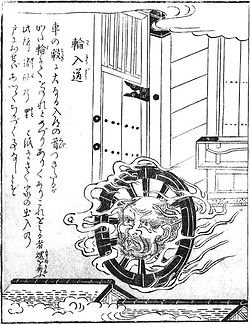
The women at the spring
echoed these shouts as the wheel rushed by them.
Often the fire went out of its own accord before
it reached the river, but should the waters of
the river extinguish it, an abundant vintage was
forecast for that year ...
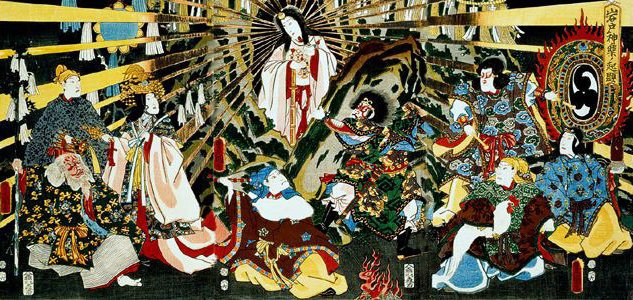
|
